
- Source: Flaunt Magazine
- Author: KANDIS WILLIAMS
- Date: SEPTEMBER 1, 2021
- Format: PRINT AND DIGITAL
KANDIS WILLIAMS
NOTES ON DANCE
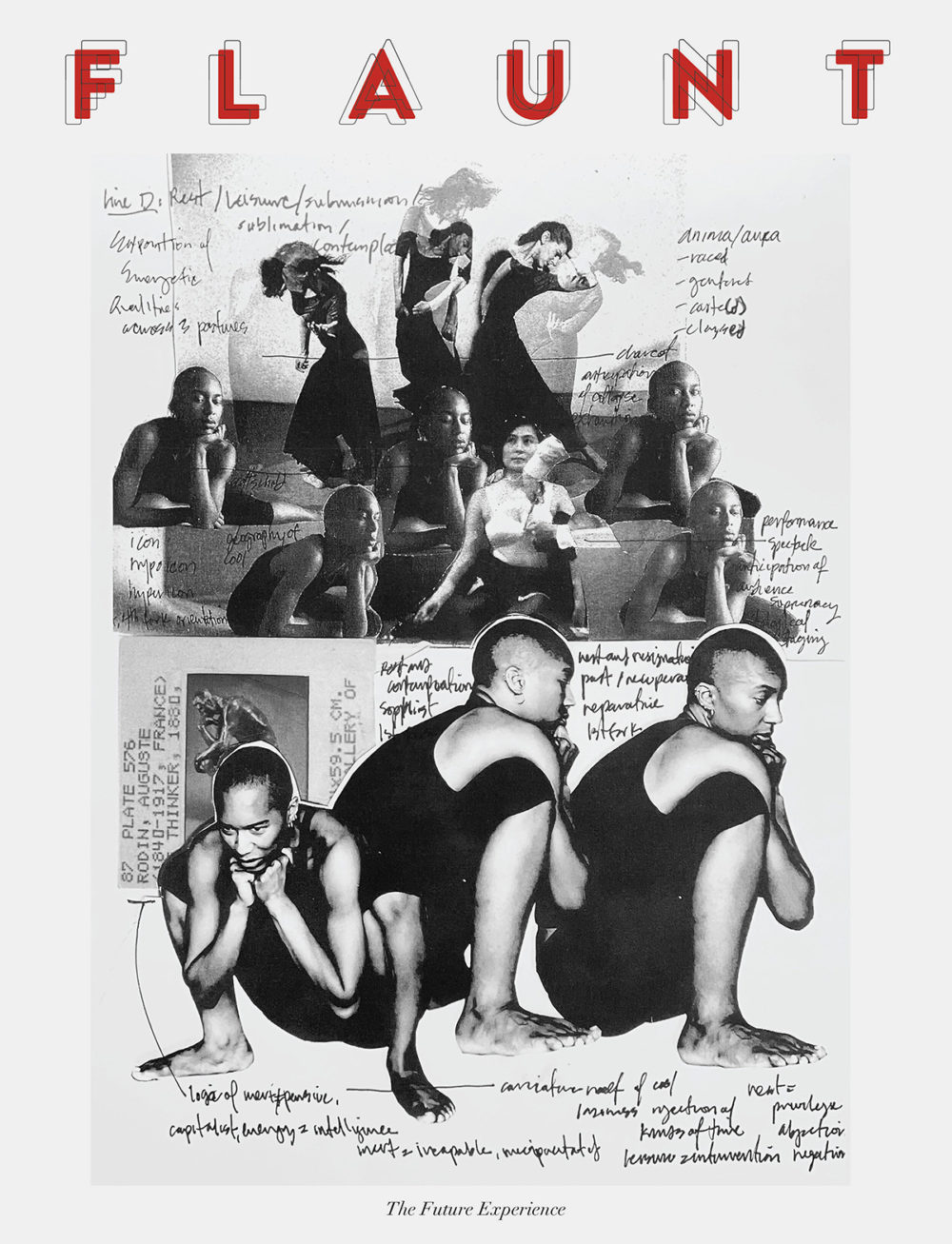
Kandis Williams. "Notes Line C Exposition" (2021). © Kandis Williams. Courtesy the artist and Night Gallery, Los Angeles.
Kandis Williams is a contemporary artist, publisher, writer, editor, and educator. Born in Baltimore—and currently based between The Big Orange and Berlin—this October, Williams will inaugurate 52 Walker, a new David Zwirner galleries’ root extension in New York City, programmed by Ebony L. Haynes.
Williams is currently in residence in NYC, sitting for portraits and late night texting with magazines like the one you’re holding, creating works for the Fall show. Additionally, the artist is currently featured in The Hammer Museum’s biennial, “Made in L.A. 2020: a version”, where she was granted the affiliated Mohn Award for artistic excellence this July. Williams is also the recipient of the 2021 Grants to Artists award, presented by the Foundation for Contemporary Arts, New York.
Beyond Williams’ contemporary arts practice, which includes collage, performance, video, assemblage, and installation, the Cooper Union alum has an active curatorial and community practice, where in proxy she runs Cassandra Press—a 501(c)(3) publishing and educational platform, which produces printed matter, projects, artist books, and exhibitions. She is currently a visiting faculty member at the California Institute of the Arts.
Williams created the cover art for this edition—The Future Experience—and her commitment to contextualizing the cover within her preparatory process ahead of the 52 Walker show, is exemplified in the following notes and observations.
***
Presented is a selection of notes on dance.
—Kandis Williams

NIKE sweatshirt, DIOR skirt and bracelet, DR. MARTENS boots, JENNIFER FISHER ear- ring, cuff, and rings, and BOND HARDWARE rings.
Candombe/ Milonga
Candombe is a style of music and dance that immigrated to Uruguay with enslaved Africans.
To a lesser extent, candombe is practiced in Argentina, Paraguay, and Brazil.
African-Uruguayans organized candombe dances every Sunday and on special holidays such as New Year’s Eve, Christmas, Saint Baltasar, Rosary Virgin, and Saint Benito.
The typical characters on the parade represent the old white masters during slavery in old Montevideo city. These characters were a mockery to the masters’ lifestyle, with a rebel spirit for freedom and a way to remember their African origins.
Many researchers agree that the Candombe, through the development of the Milonga, is an essential component in the genesis of Argentine tango.
In fact, tango, milonga, and candombe form a musical triptych from the same African roots.
Milongo
Milonga is a musical genre that originated in the Río de la Plata areas of Argentina, Uruguay, and the Brazilian state of Rio Grande do Sul.
Relationship between milongo and tango¹
“The relationship between the compadritos and the African-Argentine population in the Buenos Aires suburbs gave birth to the tango dance, which started as a result of the compadritos’ mockery of the Black people’s dances with an important difference: the Blacks danced separated and the compadritos danced embraced.
“Diverse historians affirm that the word tango derives from the name (in the slang of the Black people) of their dancing places, known as tambos and, later, tangos. It is widely accepted that the mocking new choreography was taken to the brothels by the compadritos before tango music really existed as such.”²
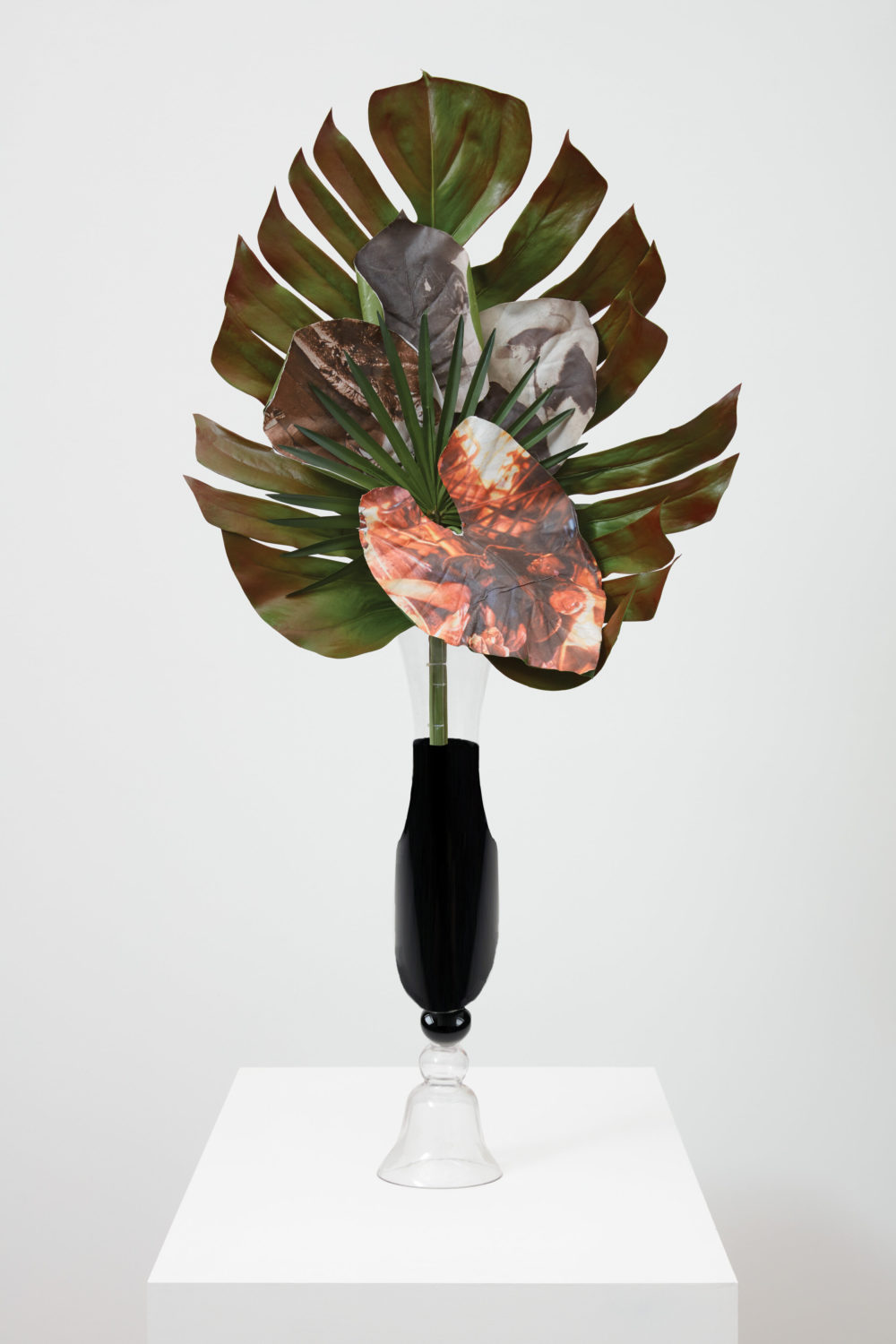
Kandis Williams. “candyman urban threat modeling, becky, karen, nike, athena: a future foreclosed to all but king kong and faye wray” (2020).
Collage on artificial plant and India ink in vase. 60” x 30” x 20”. © Kandis Williams. Courtesy the artist and Night Gallery, Los Angeles.
AND
Notes on Dance, 2013:
An exercise of sets.
“ephemerality is not really legit any longer” dance can become a model for thought, the dialectic vs the experiential.
—Peggy Fehlen, Written on the body….
AND
Dance of Death, also variously called Danse Macabre (French), Danza de la Muerte (Spanish), Danza Macabra (Italian), Dança da Morte (Portuguese), Totentanz (German), Dodendans (Dutch), Surmatants (Estonian), Dansa de la Mort (Catalan) is an artistic genre of late-medieval allegory on the universality of death: no matter one’s station in life, the Dance of Death unites all. The Danse Macabre consists of the dead or personified Death summoning representatives from all walks of life to dance along to the grave, typically with a pope, emperor, king, child, and labourer. They were produced to remind people of the fragility of their lives and how vain were the glories of earthly life. [1] Its origins are postulated from illustrated sermon texts; the earliest recorded visual scheme was a now lost mural in the Saints Innocents Cemetery in Paris dating from 1424–25.³
AND
“MARVEL NOT,” SHE SAID, “IF YOU BELIEVE THAT LOVE IS OF THE IMMORTAL, AS WE HAVE SEVERAL TIMES ACKNOWLEDGED; FOR HERE AGAIN, AND ON THE SAME PRINCIPLE TOO, THE MORTAL NATURE IS SEEKING AS FAR AS IS POSSIBLE TO BE EVERLASTING AND IMMORTAL: AND THIS IS ONLY TO BE ATTAINED BY GENERATION, BECAUSE GENERATION ALWAYS LEAVES BEHIND A NEW EXISTENCE IN THE PLACE OF THE OLD. NAY EVEN IN THE LIFE, OF THE SAME INDIVIDUAL THERE IS SUCCESSION AND NOT ABSOLUTE UNITY: A MAN IS CALLED THE SAME, AND YET IN THE SHORT INTERVAL WHICH ELAPSES BETWEEN YOUTH AND AGE, AND IN WHICH EVERY ANIMAL IS SAID TO HAVE LIFE AND IDENTITY, HE IS UNDERGOING A PERPETUAL PROCESS OF LOSS AND REPARATION-HAIR, FLESH, BONES, BLOOD, AND THE WHOLE BODY ARE ALWAYS CHANGING. WHICH IS TRUE NOT ONLY OF THE BODY, BUT ALSO OF THE SOUL, WHOSE HABITS, TEMPERS, OPINIONS, DESIRES, PLEASURES, PAINS, FEARS, NEVER REMAIN THE SAME IN ANY ONE OF US, BUT ARE ALWAYS COMING AND GOING; AND EQUALLY TRUE OF KNOWLEDGE, AND WHAT IS STILL MORE SURPRISING TO US MORTALS, NOT ONLY DO THE SCIENCES IN GENERAL SPRING UP AND DECAY, SO THAT IN RESPECT OF THEM WE ARE NEVER THE SAME; BUT EACH OF THEM INDIVIDUALLY EXPERIENCES A LIKE CHANGE.
“FOR WHAT IS IMPLIED IN THE WORD ‘RECOLLECTION,’ BUT THE DEPARTURE OF KNOWLEDGE, WHICH IS EVER BEING FORGOTTEN, AND IS RENEWED AND PRESERVED BY RECOLLECTION, AND APPEARS TO BE THE SAME ALTHOUGH IN REALITY NEW, ACCORDING TO THAT LAW OF SUCCESSION BY WHICH ALL MORTAL THINGS ARE RESERVED, NOT ABSOLUTELY THE SAME, BUT BY SUBSTITUTION, THE OLD WORN-OUT MORTALITY LEAVING ANOTHER NEW AND SIMILAR EXISTENCE BEHIND UNLIKE THE DIVINE, WHICH IS ALWAYS THE SAME AND NOT ANOTHER? AND IN THIS WAY, SOCRATES, THE MORTAL BODY, OR MORTAL ANYTHING, PARTAKES OF IMMORTALITY; BUT THE IMMORTAL IN ANOTHER WAY. MARVEL NOT THEN AT THE LOVE WHICH ALL MEN HAVE OF THEIR OFFSPRING; FOR THAT UNIVERSAL LOVE AND INTEREST IS FOR THE SAKE OF IMMORTALITY.”
“…THINK ONLY OF THE AMBITION OF MEN, AND YOU WILL WONDER AT THE SENSELESSNESS OF THEIR WAYS, UNLESS YOU CONSIDER HOW THEY ARE STIRRED BY THE LOVE OF AN IMMORTALITY OF FAME. THEY ARE READY TO RUN ALL RISKS GREATER FAR THAN THEY WOULD HAVE FOR THEIR CHILDREN, AND TO SPEND MONEY AND UNDERGO ANY SORT OF TOIL, AND EVEN TO DIE, FOR THE SAKE OF LEAVING BEHIND THEM A NAME WHICH SHALL BE ETERNAL. DO YOU IMAGINE THAT ALCESTIS WOULD HAVE DIED TO SAVE ADMETUS, OR ACHILLES TO AVENGE PATROCLUS, OR YOUR OWN CODRUS IN ORDER TO PRESERVE THE KINGDOM FOR HIS SONS, IF THEY HAD NOT IMAGINED THAT THE MEMORY OF THEIR VIRTUES, WHICH STILL SURVIVES AMONG US, WOULD BE IMMORTAL? NAY,” SHE SAID, “I AM PERSUADED THAT ALL MEN DO ALL THINGS, AND THE BETTER THEY ARE THE MORE THEY DO THEM, IN HOPE OF THE GLORIOUS FAME OF IMMORTAL VIRTUE; FOR THEY DESIRE THE IMMORTAL.”⁴
AND
*Jean-Martin Charcot (1825 –1893) French neurologist and professor of anatomical pathology. He is known as “the founder of modern neurology” 1878 Studies for treating Hysteria with Hypnosis.*
To note:
In this vein, I’d like to think through transcendental states via endurance, pain, denial, refusal, restriction, and how the body occupies such space*. Where are guidelines of social dance, how do its varied psychological states enter into and function in the space of dance theater? When ‘hysterical’ ie fugitive, disabled, Black, gendered, hyper surveilled bodies are taken as scripts by theatrically trained interpreters, where are the theaters of the medical and legal amphitheater (courts, hospitals, schools) internalized in the body of the patient, dancer, fugitive, non-citizen, cartoon?
AND
* two quotes 1) Ettinger: “matrixial participation of multiple bodies, co-mingling to the end of self-categorization” 2) Ligia Lewis: “be a sympathetic body, the dancer’s greatest gift is the ability to hold multiple and probably contradictory beliefs at once. A practice of authentic movement and inauthentic movements to remind yourself that the distance between authentic and inauthentic is a matter of taste.”
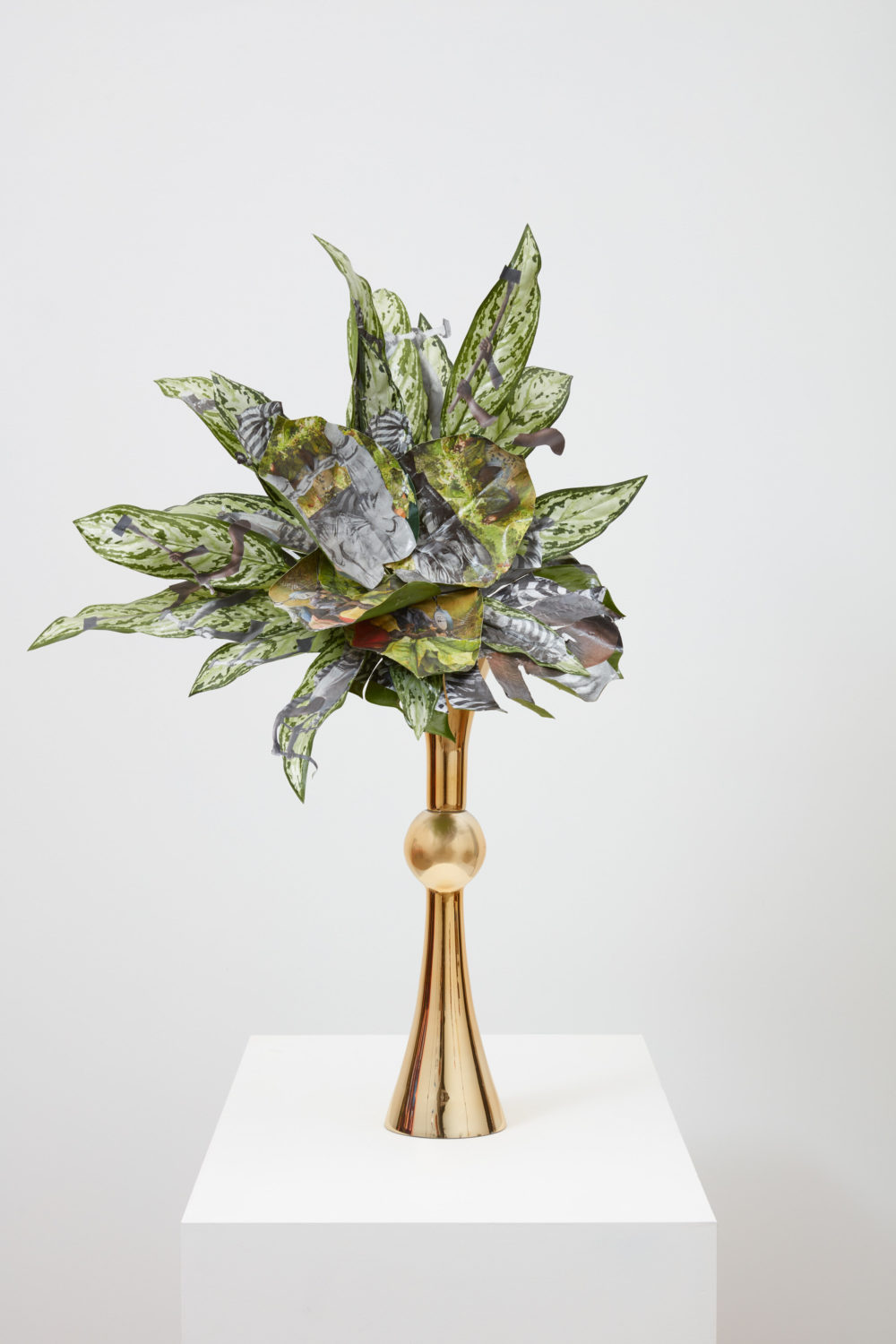
Kandis Williams. “Unlike penal systems, geological formations fail to respect the arbitrary line of state borders.” (2020).
Collage on artificial plant. 60” x 35” x 20”. © Kandis Williams. Courtesy the artist and Night Gallery, Los Angeles.
Notes for the concept of the score with lina venegas, 2017:
hijikata girl
Wigman witch
performance of a histrionic vessel—offer the feminine as a living dimensional surface, a living and but not moving sculpture; a woman or vine that grows, lurks, and stretches towards light and recedes into shadow. Moving and co-joining a greater audience and their bodies through the passing of smoke from lung to lung to air to air and the use of mirrored armor—binding her body to the eyes of the viewer—compelling complicity in the scopic—that is beyond our hyper-colonized language of difference.
Drumming and low light compelling an audience toward an environment, a sensorial lack and excess.
Hijikata’s scare, a movement analogy to the Wigman in its grounded seated posture, is hyper vulnerable yet sardonic and steeped in scandal and spectacle. Dancer must commit to hyper exposed gestures and navigate the ‘hiding from’ or ‘being captured’ by the eye. A negotiation of seductive and expansive movements that alert sexual and hyper feminine associations. These associations are alerted differently, reconfigured through the Hexentanz witch figure. This figure, historically mired in the appropriation of Japanese dance of its time, exploits a kind of fetishistic relationship to forms deemed ‘exotic’ as though forms ‘othered’ anthro-ethnic affect regime placements give a possessing/of/access/to the supernatural, animalistic, thus largely laborious—this is process of ‘primitivisation,’ the dancer here has the task of relieving and possessing the ‘text’ of the Wigman performance from the appropriation, transforming the witch figure into an answer to the STAGED vulnerability of A Girl.⁵
AND
Dance and Copyright
2020/1 Notes on Cultural Property, gathered with the help of the brilliant Clara Lee
According to the 1976 Copyright Act: a work of dance is qualified for protection as “pantomimes and choreographic works”
Section 102. Subject matter of copyright: In general
(a) Copyright protection subsists, in accordance with this title, in original works of authorship fixed in any tangible medium of expression, now known or later developed, from which they can be perceived, reproduced, or otherwise communicated, either directly or with the aid of a machine or device. Works of authorship include the following categories:
(1) literary works;
(2) musical works, including any accompanying words;
(3) dramatic works, including any accompanying music;
(4) pantomimes and choreographic works;
(5) pictorial, graphic, and sculptural works;
(6) motion pictures and other audiovisual works;
(7) sound recordings; and
(8) architectural works.
(b) In no case does copyright protection for an original work of authorship extend to any idea, procedure, process, system, method of operation, concept, principle, or discovery, regardless of the form in which it is described, explained, illustrated, or embodied in such work.⁶
However, the copyright law does not so much as cover “dance” explicitly, instead:
For copyright purposes, choreographic works are a subset of dance and are not synonymous with dance. The drafters of the copyright law also made clear that choreographic works do not include social dance steps and simple routines. Registrable choreographic works are typically intended to be executed by skilled performers before an audience—Circular 52 Copyright Registration of Choreography and Pantomime (pdf)
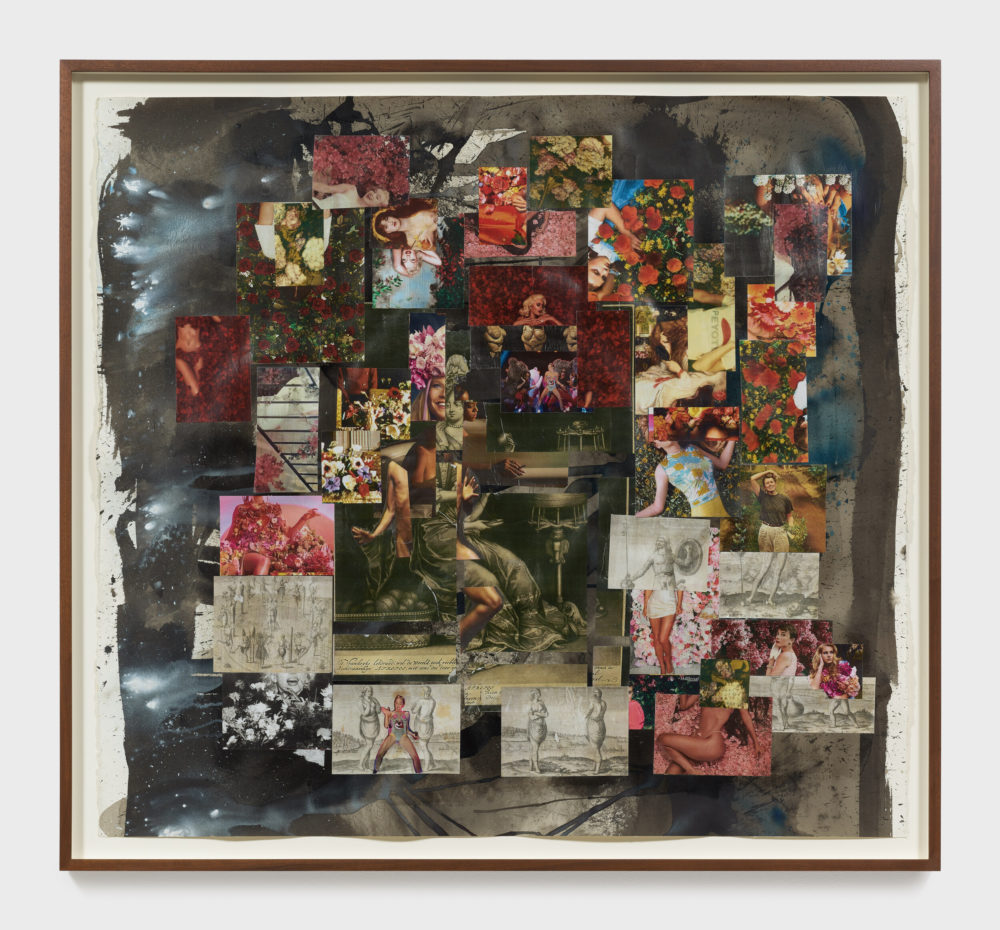
Kandis Williams. “Because the forest is so densely grown with thistles and thorns, I had to send my slaves ahead of me with axes to hack out an opening for me to uncover specimens. Feet don't fail me now Take me to the finish line. Oh, my heart, it breaks every step that I take, But I'm hoping at the gates, they'll tell me that you're mine.” (2020). Xerox collage and ink on watercolor paper. 47” x 51”. © Kandis Williams. Courtesy the artist and Night Gallery, Los Angeles.
AND
Fortnite
Epic Games offers Fortnite game play for free—but users pay for virtual clothing or various “emotes”—dances that allow users to express themselves online during in-game play. Fortnite players paid some $2.4 billion in 2018 for the right to engage in such expressions.
“Since then, although the US Copyright Office has rejected ‘the Cartlon’, for being too short of a dance routine, it has also granted registration for ‘the Random’ as a motion picture and ‘the Floss’ as choreography.”⁷
AND
Tik Tok appendix
Unfinished application to theater program, 2012
…there is the vital process of changing the actor into a monster, which is imposing certain aesthetic signifiers of monsterdom onto a living person… I try to deconstruct standardized art-historical narratives and their political implications and reassemble them. What emerges is a totem of masks and skins that project outward, and off the wall … able to open up their meaning and interpretations by engaging with their transubstantiate or talismanic values… an ethnographic form of glimmering opacity and transparency…
…there is a magic that occurs when a group or individual is able to attach its feelings about culture, identity, and power to an object. In an after school program that I taught in Bronx, I showed the 8th grade boys class Roman Coins, and had them design coins which they felt represented their community (and by implication its sources and symbols of power, and importance to culture). A kid whose coin depicted the World Trade Center bombings told me that his coin was not in memory of the actual event, but inspired by the image of the towers falling, made by folding $5 bills in a certain way. The coin was a signifier for a precise fold he deemed able to emit or admit a fate, a destiny within a commonly held bill. This creative magic plays a role in the formation of new historical narratives….
AND
A man emerged from the crowd of other travelers around the time we got to Cleveland.
In Indianapolis, he asked me if he could buy me a cup of tea.
I accepted.
I trusted his cane and Kangol hat.
He gave me his pillow in Missouri, said he didn’t need it.
I accepted.
I slept with it till Kansas, we’d spent our first day together, him sitting behind me, me twisted up luxuriously on the two free seats I’d managed to maintain from Baltimore until Oklahoma. A chat and a tea at every stop had made us friends.
It wasn’t until the bus got crowded after a bad connection in Utah, forcing us to sit together that he started to feel less friendly.
A few hours outside of Las Vegas he invited me to stay with him in his ex-wife’s house while she was away. Apparently they loved each other very much but a daughter of hers from a previous marriage caused their separation. She was delivering the daughter to another part of the country while he took refuge with relatives in Cleveland, he would return a few days before her.
Eventually, He asked me if I’d like to stay with him while she was away.
I declined.
Told him I was expected in Los Angeles.
He put his pillow in his lap and asked if I was still tired.
I declined.
He offered another story of his loving wife.
His wife was a very clever woman, she’d grown up in Los Angeles. She knew all about the vampires that lived there and had taken him to a park where they congregated. They walked hand in hand through that park, through an air of whispers and the feeling of being followed by dozens of gleaming eyes. She was the first person who’d shown him a nest of them, an outdoor hub of things that lived off the living. “If you got people that care about you, they won’t mess with you. But don’t sleep on the streets in Los Angeles, or they’ll get you in time.”
Los Angeles, he warned, was infested.
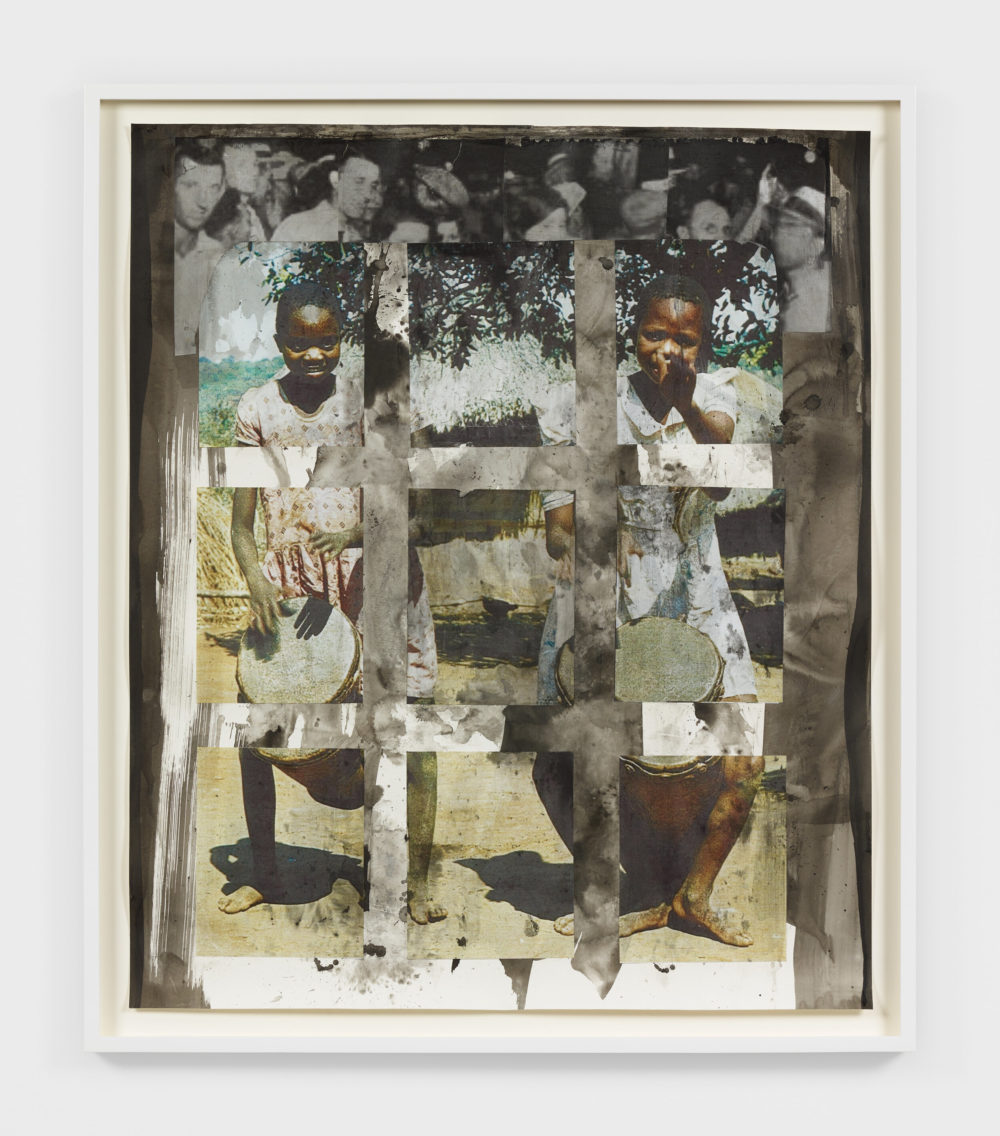
Kandis Williams. “transformed relations-without-relating” (2019). Xerox collage and ink on paper, framed. 43 ⅘” x 35 ¾”. © Kandis Williams. Courtesy the artist and Night Gallery, Los Angeles.
¹http://www.caminitoamigo.com/the-tango-milonga-relationship
²Selected Notes on Black Erotic, 2020 Books:Lawrence Ross. Money Shot: The Wild Nights and Lonely Days Inside the Black Porn Industry (2007) Mireille Miller-Young. A Taste for Brown Sugar: Black Women in Pornography (2014) Et Al. The Feminist Porn Book: The Politics of Producing Pleasure (2013) Ariane Cruz. The Color of Kink: Black Women, BDSM, and Pornography (2016) Et Al. Porn Archives (2015) Nash, J. C. The Black body in ecstasy: Reading race, reading pornography (2014) Brenda Dixon Gottschild. Joan Myers Brown & the Audacious Hope of the Black Ballerina: A Biohistory of American Performance (2011) Collection: Jim Jager/ Third World Studio https://www.metmuseum.org/art/collection/search/283338 “Jager‘s studio, founded in 1976 in Chicago, specialized in soft-core pornography featuring casually posed Black male models. His photographs, stripped of the fantastic scenarios frequently contrived in erotica, were included in self-published magazines unabashedly titled Black Sugar, Black Roots, Black Fever, Black Knights, Black Gold, Black Stars, and Black Thunder.
³https://en.wikipedia.org/wiki/Danse_Macabre
⁴Socrates and Diotima. “Geneology of Love: from Plato’s Symposium” (204D-209E)
⁵Dramaturgy: Eduardo Kohn. “Thinking with a Forest’s Thoughts”; “Shades of Intimacy: What the Eighteenth Century Teaches Us,” served as the keynote lecture for “The _Flesh_ of the Matter: A Hortense Spillers Symposium,” at Cornell University. Lecture by Hortense Spillers – March 18, 2016, Sandra Ponzanesi. Beyond the Black Venus: Colonial Sexual Politics and Contemporary Visual Practices (2005), Evelynn M. Hammonds. Toward a Genealogy of Black Female Sexuality: The Problematic of Silence. (1999). Karen Barad. Posthumanist Performativity: Toward an Understanding of How Matter Comes to Matter (2003). Images: plant prototypes, Mary Wigman ‘Hexentanz’ 1913 https://www.youtube.com/watch?v=AtLSSuFlJ5c, ‘Whereof One cannot speak thereof one must remain https://vimeo.com/209846512/e142a3f3b1-silent’ (LACE performance) Affect:Network: Territory (Human Resources LA performance)
⁶See Chapter 1: Subject Matter and Scope of Copyright of Copyright Law of the United States (Title 17)
⁷“The dance-off ends: a (partial) resolution to Fortnite’s flurry of copyright lawsuits.” https://variety.com/2018/gaming/news/fortnite-dance-lawsuit-1203092141/ https://www.theverge.com/2018/12/20/18149869/fortnite-dance-emote-lawsuit-milly-rock-floss-carlton https://www.theverge.com/2019/1/15/18184401/epic-games-fortnite-dance-emote-legal-lawsuit-2-milly-carlton-floss Additional bibliography Lee J. Matalon. “Modern Problems Require Modern Solutions: Internet Memes and Copyright” Anupam Chander and Madhavi Sunder. “Dancing on the Grave of Copyright?” Ashleigh Greene Wade. “New Genres of Being Human: World Making through Viral Blackness” Kyra D. Gaunt. “The Games Black Girls Play: Learning the Ropes from Double-Dutch to Hip-Hop (NYU press preview)”
⁸Text Collage for performance at After the Eclipse, Berlin 2015:
I Story: Kandis Williams / Poem: Camille Lacadee
II Thierry Paulin / “The Nightmare”, by Henry Fuseli (1781), generated 3D image
III Hamlet: Act 1, Scene 5. William Shakespeare in two columns
IV Original Ending of Bram Stoker’s Dracula / Screenshot of deleted scenes from Bram Stoker’s Dracula by Francis Ford Coppola
Photographer: Mark Clennon
Stylist: Gloria Johnson
Makeup: Patricia Ambroise at See Management

